Construction risk is a lot like being stuck at a red light. Nobody enjoys it, but you must overcome those red lights in order to reach your destination. That’s why conducting a thorough construction risk assessment is one of the best tactics available to contractors that are looking to minimize the threat of incident on their sites.
The article clarifies what a construction risk assessment is, how to conduct one on your projects, and provides readers with a free template that they can download and use in the future.
Table of Contents
Key Takeaways
What is a Construction Risk Assessment?
Why Risk Assessment is Essential in Construction
How to Conduct a Construction Risk Assessment in 4 Steps
1. Understand Your Duties as an Employer
2. Identify Risks On-Site
3. Evaluate Each Risk (and Prioritize Them)
4. Implement Controls (Where Necessary)
When to Perform a Risk Assessment
Construction Risk Assessment Template (Free Download)
Conclusion
Key Takeaways
- A construction risk assessment helps determine at-risk parties, create awareness around the risks present on-site, assess current loss prevention measures in-place, ensure contract requirements are upheld, and decide if additional controls need to be instituted.
- Conduct a construction risk assessment in four easy steps: understand your duties as an employer, identify risks on your project, determine the impact of those risks, then implement control measures (if necessary)
- There are three points when construction risk assessments should be conducted: in the design phase, in response to process changes or the introduction of new equipment, or when a new hazard is identified.
- Download your free construction risk assessment template here.
- myComply is a construction workforce management solution that is proven to help contractors to reduce their risk exposure and secure insurance reductions by digitizing worker certifications, tracking manpower data, and offering access control options to prevent unqualified site access.
What is a Construction Risk Assessment?
A construction risk assessment is the calculated process of identifying project specific threats on a jobsite, then analyzing and evaluating each risk factor to determine the likelihood, impact, and repercussions of each of those variables.
A construction risk assessment should aim to achieve a couple of items:
- Determine who is at risk and what they are at-risk of, be they employees or site visitors
- Create awareness surrounding the risks/hazards identified
- Assess current risk prevention measures that are in-place to determine if they are sufficient or if further action needs to be taken
- Ensure that any (and all) legal requirements or contract requirements are being met regarding risk
- Decide if additional controls need to be implemented or if changes need to be made to your construction risk management strategy
Why a Risk Assessment is Essential in Construction
The construction sector is arguably the most dangerous and risky in the world. If you’re responsible for assessing and managing risk on a construction project, here are a few of the many reasons why your work is so essential:
- One in every five worker fatalities in the United States is in the construction sector.
- 1,008 construction workers died on the job in 2020.
- Every year, 1% of construction workers miss work due to a serious injury.
- Fatal construction injuries are estimated to cost the United States five billion each year in health care, lost income, lost production, etc.
- Workers’ compensation claims for nonfatal falls account for $2.5 billion
How to Conduct a Construction Risk Assessment in 4 Steps
Construction risk assessments don’t need to be overly complex. Collect past project data, determine what regulations you are bound by, begin identifying risks, prioritize them, then implement controls where deemed necessary.
1. Understand Your Duties as an Employer
As you craft your construction risk assessment strategy, you need to be aware of your duties as an employer, as outlined by the Occupational Safety and Health Administration (OSHA), as well as any state-specific legislation that may affect operations on your site.
Under OSHA, the key provisions that General Contractors need to be aware of are as follows:
2. Identify Risks On-Site
There is no shortage of risk present on a construction project. General Contractors and Construction Managers must be aware of financial risks, environmental risks, safety risks, productivity risks, as well as document, legal, and contract risks.
With so much risk, it can be difficult to identify every hazard or threat to safety, productivity, or profitability. Fortunately, there are some steps that can be taken to help contractors to map risks across their projects:
- Consult a list of construction risks. It can be helpful to see what some of the most frequently assessed risks are on construction projects. Check out this list of construction risks to get you started.
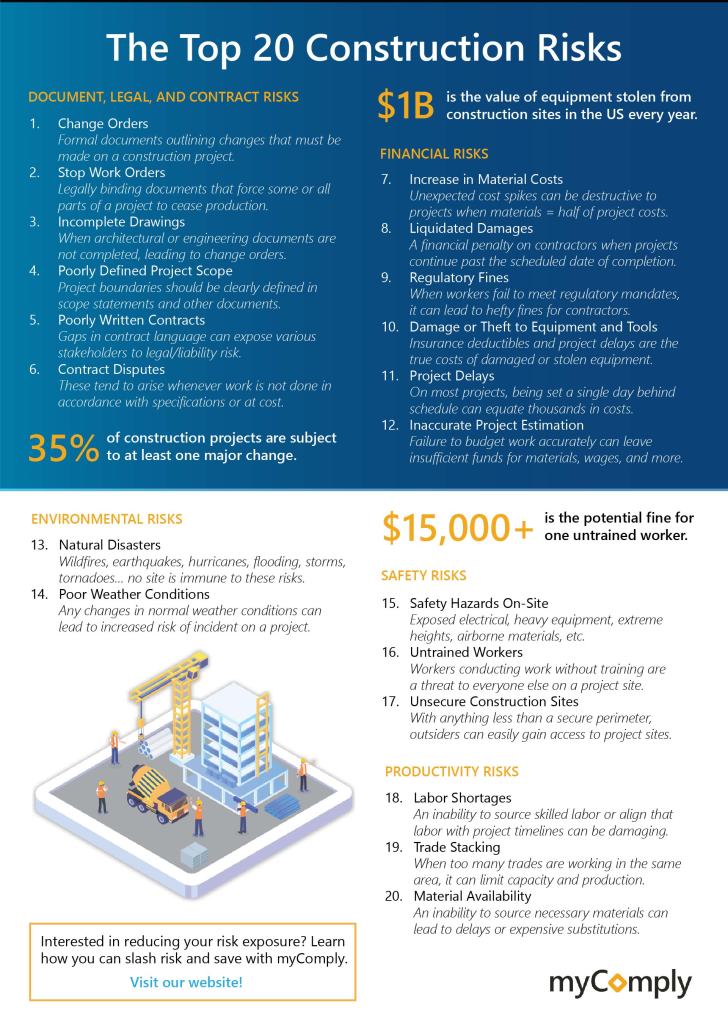
Download your copy of the top 20 construction risks today!
- Refer to past project data. Documentation such as incident reports from previous projects can help you to predict the types of risks that your projects are generally prone to. Use your platform to mine this data.
- Anticipate unusual conditions. Are severe storms frequent in your area? What about power outages? It is better to be overprepared than caught off-guard by extreme or unusual conditions.
- Determine group-specific risks. For example, the workers employed by an electrical Subcontractor are going to be more susceptible to the risk of electrocution as compared to those employed by a concrete contractor.
Now, compile all your risks into a comprehensive list, including risk-specific details, such as:
- Risk name
- Risk description, including conditions/situations where the risk is prone to occur
- Risk response strategy (if one exists)
- Team members (or roles) responsible for managing risk
Once compiled, you are ready to assess each risk to determine priority and necessary controls.
3. Evaluate Each Risk (and Prioritize Them)
Now that you’ve identified the risks that you are anticipating on your project, it’s time to prioritize them by conducting a two-factor assessment. The two factors are:
- The potential impact on your business (dollar amounts)
- The chance of the risk materializing (percentage points)
Once you have determined the potential financial impacts of the risk (in dollars) and the chance of that risk occurring (based on previous project data), then you should plot each risk on a simple 5×5 grid, based on probability and impact.
How to use this grid to score risk:
- Use tangible dollar amounts and percentage points to assign a impact and likelihood score (1-5) for each risk.
- Plot your risk to one of the squares below
- Multiple your x-axis score by your y-axis score to get a total risk score (ex. impact = 4, likelihood = 2, total risk score = 8)
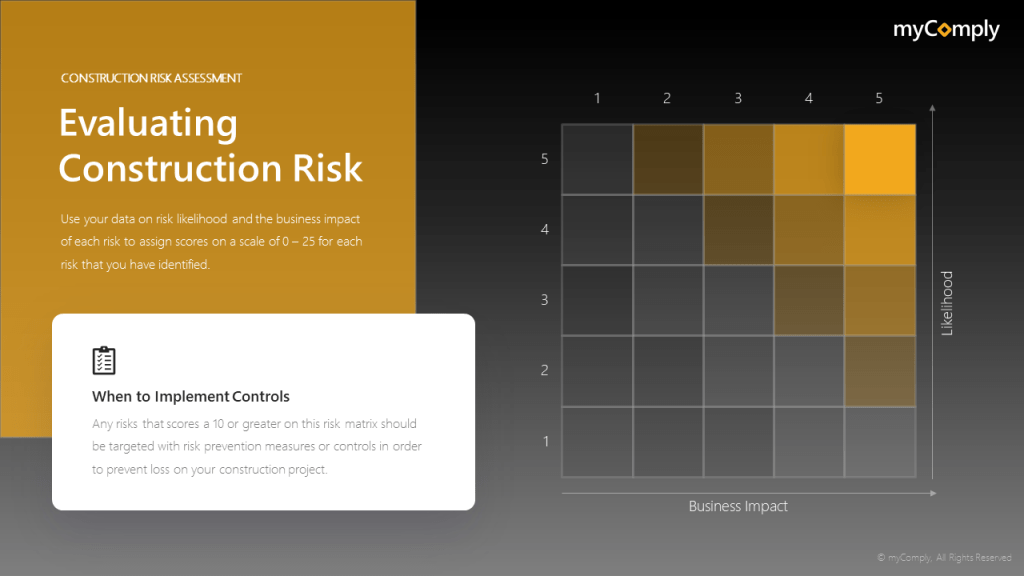
Once you’ve determined the highest-ranking risks, based on impact and likelihood, you can determine whether existing controls will be sufficient to manage risk or whether new controls will have to be instituted to reduce your risk exposure.
4. Implement Controls (Where Necessary)
If you are using our risk evaluation matrix, we suggest that you consider implementing or auditing controls on all risks that score higher than 10 (the orange region on the above diagram), based on the impact and likelihood criterion.
When implementing controls, there are four possible techniques that contractors can leverage:
- Avoid the risk. Not all risks can be avoided, but changes in the scope of work or selective project bidding can help to eliminate certain risk. For example, you may want to avoid bidding on multi-storey projects if you want to prevent the risk of workers falling from heights.
- Transfer the risk. This is the process of transferring the liability or responsibility of a risk to an external party. For example, most contractors enroll in workers’ compensation insurance to cover the costs of workers who are injured or become sick due to their work. General Contractors can also transfer some risk to their suppliers and Subcontractors.
- Mitigate the risk. Create plans or processes that eliminate the risk from the equation on your projects. For example, if you want to mitigate the risk of unwanted foot traffic entering your project site, then you may want to implement a construction site access control system in conjunction with a secure site perimeter.
- Accept the risk. Some risks are simply unavoidable in construction or may need to be embraced to stay on schedule or to prevent additional risk to workers. For example, extreme weather conditions could mean that work must be halted for a day or two on a project site to prevent any risk to worker safety. This could lead to delays on the project but may be deemed acceptable in exchange for the risk reduction to worker safety.
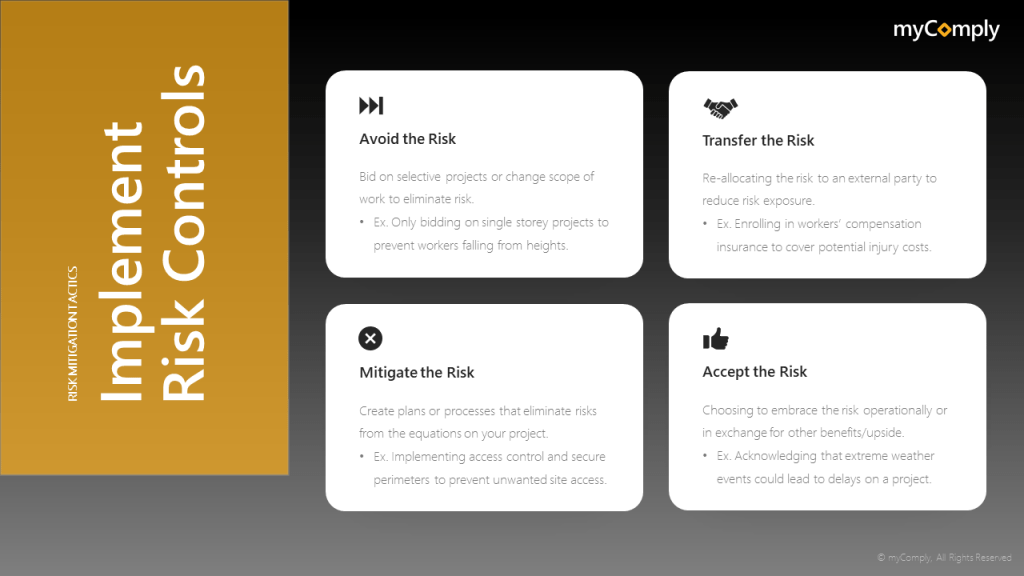
Some risks can be easily mitigated, others must be avoided or accepted, and some can be transferred to insurance providers and other entities. Use your discretion and your risk evaluation scoring to help you determine the best course of action for each risk on your project.
When to Perform a Risk Assessment
There are three circumstances which offer suitable opportunities to perform construction risk assessments on your construction project.
- During the design phase. The first opportunity for contractors to assess risk on their project is before work has begun. This is when potential hazards should be identified, circumstances that might invoke hazards, and when plans can be put in-place to prevent risk once work begins.
- Introduction of a new process or new equipment. Whenever new processes or new equipment are brought onto a project, it is wise for contractors to assess those changes accordingly. For example, if your project management team decided to launch a new online orientation process for workers, then it might be wise to conduct a risk assessment to evaluate the impacts of this change in process.
- Identification of a hazard. It’s not always possible to forecast or predict every risk that might be present on a construction project, which is why contractors need to be flexible and ready to assess new risks as they arise. For example, consider the impacts on a site if there was freezing rain the night before, leaving many walking and working surfaces coated with ice. Though this may be a short-term problem, it still warrants assessment so that workers can feel safe and secure conducting work under these conditions.
Construction Risk Assessment Template (Free Download)
Looking to conduct a construction risk assessment on a project site? Make it easy by downloading this free template to streamline your assessment.
Click here to download your process diagram!
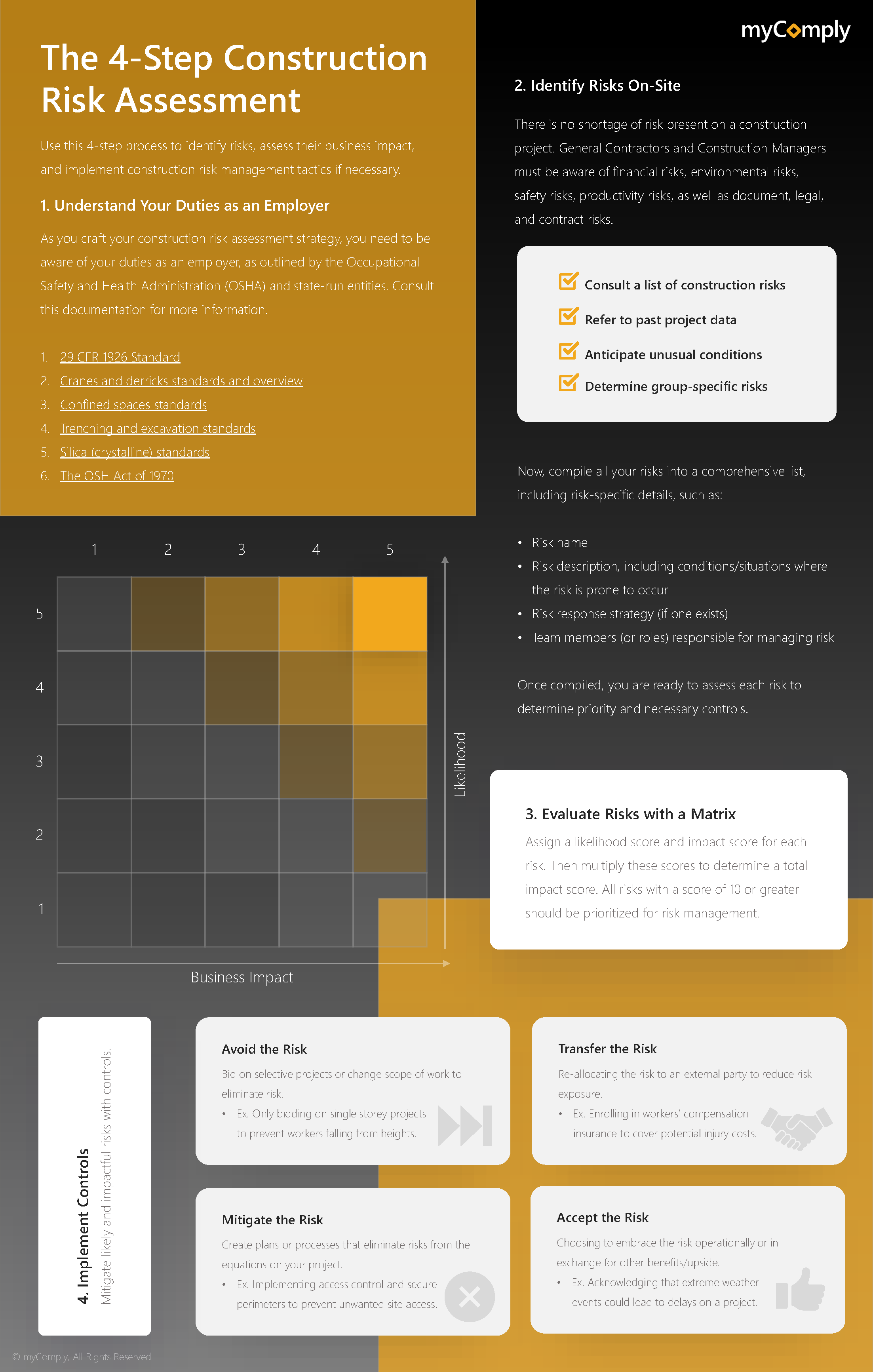
Conclusion
Conducting a comprehensive construction risk assessment is the first step towards improving the safety and productivity of operations on your construction site. Use the tools and tactics provided in this article to improve your risk management program.
myComply is the leading construction workforce management platform for General Contractors that want to reduce their risk exposure by implementing proactive and preventative labor solutions. myComply reduces risk in five key areas:
- Eliminate regulatory fines
- Prevent stop work orders
- Win contract disputes
- Prevent unqualified site access
- Reduce the risk of vandalism and theft
Interested in finding out more? Explore our website or book a demo with a product expert to see our software in action.

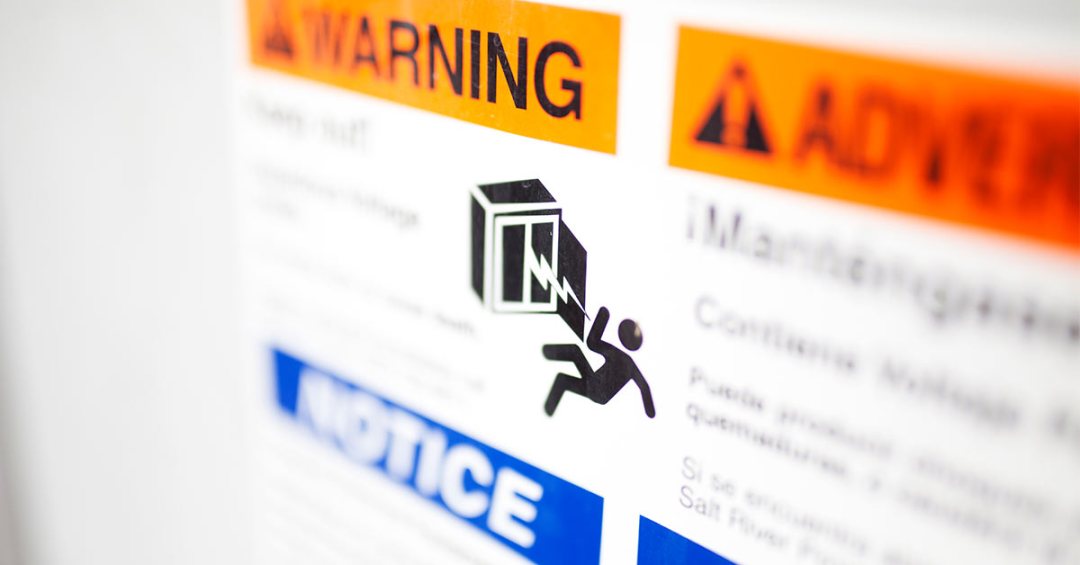

In my opinion, this is now a very complicated process. Starting from workplace safety to anticipating problems with logistics or financing. All factors can lead to problems and risks in a construction project.